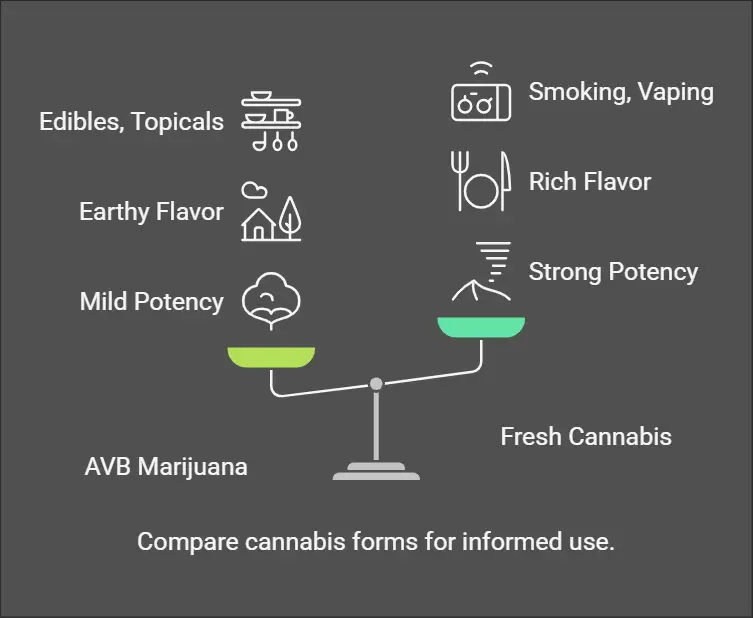Introduction
For many cannabis users, the journey doesn’t end after a session with their favorite strain. What remains—Already Vaped Bud (AVB) —is often overlooked but holds untapped potential. AVB marijuana refers to the leftover plant material after vaporization, which still contains valuable cannabinoids and terpenes. Instead of discarding it, savvy users can repurpose AVB into edibles, topicals, or other innovative creations.

In this article, we’ll explore everything you need to know about using AVB marijuana, including its chemical composition, consumption methods, effects, and practical tips for maximizing its value. Whether you’re a seasoned cannabis enthusiast or new to the concept of reusing AVB, this guide will equip you with actionable insights to make the most of your cannabis experience.
Table of Contents
- What is AVB Marijuana?
- Definition and Basics
- Why It’s Worth Saving
- Chemical Composition of AVB Marijuana
- THC, CBD, and Terpene Residues
- Effects on Mind and Body
- Creative Ways to Use AVB Marijuana
- Edibles and Infusions
- Topicals and Salves
- Composting and Sustainability
- How to Properly Store AVB Marijuana
- Best Practices for Preservation
- Avoiding Mold and Degradation
- Comparison Table: AVB vs. Fresh Cannabis
- Potency and Effects
- User Preferences
- Consumption vs. Quality Analysis
- Dosage Recommendations
- Long-Term Benefits
- Frequently Asked Questions (FAQs)
- Common Queries About AVB Marijuana
- Conclusion
1. What is AVB Marijuana?
Definition and Basics
Already Vaped Bud (AVB) is the residual plant material left over after vaporizing cannabis. Unlike smoking, which burns the plant material completely, vaporization heats the cannabis just enough to release cannabinoids and terpenes without destroying the entire bud. While some compounds have been extracted during vaping, plenty remains to work with.
Why It’s Worth Saving
Reusing AVB is not only cost-effective but also environmentally friendly. By transforming it into edibles, tinctures, or even compost, you reduce waste and extend the utility of your cannabis. Additionally, AVB retains mild psychoactive properties, making it suitable for crafting milder products compared to fresh cannabis.
2. Chemical Composition of AVB Marijuana
THC, CBD, and Terpene Residues
Even after vaporization, AVB contains trace amounts of cannabinoids and terpenes. Here’s a breakdown of what remains:
Compound Percentage (%)
THC 2-5%
CBD <1%
Myrcene Trace
Limonene Trace
Caryophyllene Trace
Chemical Composition of AVB Marijuana
When cannabis is vaporized, heat extracts cannabinoids like THC and CBD, as well as aromatic compounds called terpenes, from the plant material. However, not all of these compounds are fully consumed during the process. The leftover material—Already Vaped Bud (AVB) —still contains trace amounts of cannabinoids and terpenes, though their concentrations are significantly lower than in fresh cannabis. Understanding what remains in AVB is crucial for determining how it can be reused effectively.
1. THC (Tetrahydrocannabinol): 2-5%
What is THC?
THC (tetrahydrocannabinol) is the primary psychoactive compound in cannabis responsible for the “high” that users experience. It interacts with the brain’s endocannabinoid system, binding to CB1 receptors, which regulate mood, memory, appetite, and pain perception.
Why Does THC Matter in AVB?
Even after vaporization, AVB retains 2-5% THC, which is enough to produce mild psychoactive effects. While this is far less potent than fresh cannabis (which typically contains 15-30% THC), the remaining THC can still contribute to relaxation, euphoria, or mild stress relief when used creatively. For example:
- Edibles: Infusing AVB into butter or oil allows you to extract and concentrate the remaining THC for use in baked goods or beverages.
- Topicals: When applied externally, the residual THC may offer localized soothing effects without inducing a psychoactive high.
Implications of Reduced THC Content:
- Milder Effects: The low THC levels make AVB ideal for crafting products with subtle psychoactive properties, suitable for beginners or those sensitive to THC.
- Cost-Effectiveness: Reusing AVB extends the utility of your cannabis supply, allowing you to get more value out of each session.
2. CBD (Cannabidiol): <1%
What is CBD?
CBD (cannabidiol) is a non-psychoactive compound found in cannabis known for its therapeutic benefits, including anti-anxiety, anti-inflammatory, and neuroprotective properties. Unlike THC, CBD does not produce a “high.”
Why is CBD Low in AVB?
The AVB strain contains less than 1% CBD, indicating that most of the CBD has been extracted during vaporization. This makes AVB less suitable for medical applications requiring significant CBD concentrations, such as treating epilepsy or severe anxiety.
Implications of Minimal CBD Content:
- Limited Therapeutic Use: While AVB may provide mild relaxation, it won’t deliver the robust therapeutic benefits of high-CBD strains.
- Focus on THC-Dominant Effects: The low CBD content means THC and other minor cannabinoids primarily drive the remaining effects.
3. Terpenes: Trace Amounts (Myrcene, Limonene, Caryophyllene)
What Are Terpenes?
Terpenes are aromatic compounds in cannabis (and many other plants) that contribute to the plant’s scent, flavor, and therapeutic effects. They work synergistically with cannabinoids through a phenomenon called the entourage effect, enhancing the overall experience.
Key Terpenes in AVB:
- Myrcene (Trace Levels)
- Aroma/Flavor Profile: Earthy, musky, with hints of cloves and ripe fruit.
- Effects: Myrcene is known for its sedative properties, promoting relaxation and sleep. It also enhances the absorption of THC, amplifying its psychoactive effects.
- Role in AVB: Although present only in trace amounts, myrcene contributes to the calming effects of AVB-infused products.
- Limonene (Trace Levels)
- Aroma/Flavor Profile: Citrusy, zesty, and refreshing.
- Effects: Limonene is associated with mood elevation, stress relief, and anti-anxiety properties. It also has antibacterial and antifungal qualities.
- Role in AVB: The faint citrus notes add a touch of brightness to AVB recipes, counterbalancing the earthy base flavor.
- Caryophyllene (Trace Levels)
- Aroma/Flavor Profile: Spicy, peppery, and woody.
- Effects: Caryophyllene is unique because it interacts directly with CB2 receptors in the body’s immune system, offering anti-inflammatory and pain-relieving benefits. It also has potential anti-anxiety properties.
- Role in AVB: Caryophyllene adds a subtle spicy undertone to AVB and provides mild soothing effects when used in topicals or edibles.
Implications of Trace Terpene Levels:
- Subtle Flavor Profile: The reduced terpene content means AVB lacks the vibrant aroma and flavor of fresh cannabis, making it better suited for infused products where taste is masked (e.g., brownies or salves).
- Enhanced Synergy: Even in trace amounts, terpenes interact with cannabinoids, contributing to the entourage effect and enhancing the overall experience.
How These Components Work Together
The combination of THC, CBD , and terpenes in AVB creates a holistic experience, albeit milder than fresh cannabis:
- Potency and Psychoactivity: The remaining THC delivers mild euphoria and relaxation, making AVB suitable for crafting gentle edibles or topical treatments.
- Therapeutic Benefits: While limited, the residual cannabinoids and terpenes provide mild stress relief, anti-inflammatory effects, and localized soothing properties.
- Versatility: Despite its reduced potency, AVB can be repurposed into various products, from edibles and tinctures to compostable materials.
Practical Implications for Users
Understanding the chemical breakdown helps users tailor their consumption based on personal preferences and needs:
- Recreational Users: Those seeking a mild high can incorporate AVB into edibles or infusions for a discreet and enjoyable experience.
- Medical Users: Individuals looking for mild relief from stress or muscle tension may find AVB helpful, though strains with higher CBD might be better suited for severe conditions.
- Sustainability Enthusiasts: Repurposing AVB reduces waste and promotes eco-friendly practices, aligning with sustainable living goals.
Visualizing the Data
To make this information even clearer, here’s the table again with added context:
Compound Percentage (%) Role
THC 2-5% Provides mild psychoactive effects and contributes to relaxation and euphoria.
CBD <1% Offers minimal therapeutic benefits due to very low concentration.
Myrcene Trace Adds sedative qualities and enhances THC absorption, contributing to calming effects.
Limonene Trace Elevates mood and reduces stress; it adds a subtle citrus note to the flavor profile.
Caryophyllene Trace Provides anti-inflammatory and pain-relieving benefits and adds a spicy undertone to flavors.
- THC: While much of the THC has been extracted, AVB still retains small amounts, providing mild psychoactive effects.
- CBD: Low levels of CBD remain, contributing minimal therapeutic benefits.
- Terpenes: Most terpenes are volatile and evaporate during vaporization, leaving only faint traces behind.
Effects on Mind and Body
The reduced potency of AVB makes it ideal for creating milder products. Users report subtle relaxation and euphoria when consuming AVB-infused items, making them perfect for daytime use or those sensitive to high THC concentrations.
3. Creative Ways to Use AVB Marijuana
Edibles and Infusions
One of the most popular ways to reuse AVB is by incorporating it into edibles. Here are a few ideas:
- Cannabutter: Melt butter with AVB to create infused butter for baking cookies, brownies, or pancakes.
- Smoothies: Blend AVB into smoothies for a discreet and nutritious way to consume it.
- Tea: Steep AVB in hot water along with herbs like mint or chamomile for a soothing beverage.
Topicals and Salves
AVB can also be used to make topical products:
- Salve Recipe: Combine AVB with coconut oil and beeswax to create a soothing salve for sore muscles or irritated skin.
- Lotion Bars: Mix melted shea butter, cocoa butter, and AVB for portable lotion bars.
Composting and Sustainability
If you don’t plan to consume AVB, consider adding it to your compost pile. Cannabis is rich in nutrients like nitrogen, phosphorus, and potassium, making it an excellent addition to organic gardening efforts.
4. How to Properly Store AVB Marijuana
Best Practices for Preservation
To preserve the remaining cannabinoids and prevent spoilage:
- Store AVB in an airtight container, such as a glass jar.
- Keep it in a cool, dark place away from direct sunlight or heat sources.
- Label the container with the date to track freshness.
Avoiding Mold and Degradation
Moisture is the enemy of stored AVB. Ensure the material is dehydrated before storage. If you notice any signs of mold (e.g., white fuzz or musty smell), discard it immediately to avoid health risks.
5. Comparison Table: AVB vs. Fresh Cannabis
Aspect AVB Marijuana Fresh Cannabis
Potency Mild Strong
Flavor Profile Earthy, muted, Rich, aromatic
Uses Edibles, topicals Smoking, vaping, extracts
Shelf Life Shorter Longer
While fresh cannabis offers more potent effects and more decadent flavors, AVB provides a sustainable and versatile alternative for creative applications.
6. Consumption vs. Quality Analysis
Dosage Recommendations
Since AVB is less potent than fresh cannabis, start with smaller doses when experimenting with edibles or infusions. For example, use 1-2 teaspoons of AVB per serving in recipes.
Long-Term Benefits
Using AVB promotes sustainability and reduces waste. Over time, you’ll save money by stretching your cannabis supply further while minimizing environmental impact.
7. Frequently Asked Questions (FAQs)
Q1: Can I smoke AVB again?
A1: Technically, the flavor and potency will be significantly diminished. It’s better suited for edibles or topical uses.
Q2: Does AVB lose all its THC?
A2: No, AVB retains trace amounts of THC, though it’s far less potent than fresh cannabis.
Q3: How long does AVB last in storage?
A3: Properly stored AVB can last up to 6 months, though its quality may degrade.
8. Conclusion
AVB marijuana represents an opportunity to maximize the value of your cannabis experience while embracing sustainability. From crafting delicious edibles to creating nourishing topicals, the possibilities are endless. By understanding its chemical composition, proper storage techniques, and creative uses, you can unlock the hidden potential of this often-overlooked resource.
So, the next time you finish a vaping session, think twice before tossing out your AVB. With creativity and effort, you can transform it into something truly remarkable. Start exploring today and discover the untapped benefits of Already Vaped Bud!



